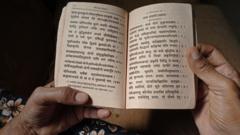India's food aid initiative has left an indelible mark on American academia, particularly enhancing the resources available for South Asian studies. In a unique twist of history, this program, known as PL-480 or the Food for Peace, allowed Indian funds to be utilized to buy books and literature for U.S. libraries.
The program began under President Dwight D. Eisenhower in 1954 during a time when India struggled with severe food shortages. The initiative permitted India to use its local currency to procure U.S. grain, thus alleviating its foreign exchange issues and saving American surpluses. The funds subsequently found their way into the libraries of institutions like the University of Chicago, establishing it as one of the leading repositories of South Asian literature and history.
Ananya Vajpeyi, a history scholar, recalls unearthing an impressive South Asia collection when she visited the University of Chicago's Regenstein Library in 1996. “Nothing has ever matched the unending riches held at the University of Chicago," she reflected, highlighting the library's extensive holdings of over 800,000 volumes related to South Asia.
The PL-480 program had a profound impact on U.S. higher education. The boosting of library collections was not merely a stroke of luck; it was meticulously orchestrated. A special team in Delhi was set up in 1959 to gather diverse publications from India, vastly improving the richness of resources available in libraries across more than thirty institutions in the U.S. By 1968, this collaboration had seen the libraries collectively receive more than 750,000 items, significantly enhancing South Asian studies.
However, as Todd Michelson-Ambelang pointed out, the flow of literature to American universities has implications for knowledge accessibility. He questioned whether this program might have drained vital literary resources from India. Indeed, many texts that were sent to the West might now be scarce in their homeland, leading to knowledge gaps for scholars who might have to travel abroad to access such materials.
The legacy of the program is undoubtedly complex. On one side, many valuable resources once proliferated in Indian libraries have found their way to better-preserved archival systems in U.S. institutions, where preservation efforts remain rigorously maintained. On the other hand, this has also contributed to the creation of colonial knowledge archives that may exclude local access for many scholars in South Asia.
Following the program's termination in the 1980s, American libraries began to bear the full financial responsibilities for the acquisition of resources. Institutions like the University of Chicago now allocate substantial budgets yearly to purchase South Asian materials independently.
While the historical trade-off between grain and books has yielded abundant academic resources for U.S. institutions, it has also raised pressing questions about the sustainability and accessibility of South Asian literary heritage within India. Despite these concerns, Vajpeyi acknowledges the undeniable benefit her studies received from the expansive resources available at UChicago, asserting the importance of having access to a well-preserved library collection.
As libraries navigate the balance between acquisition and accessibility, the narrative of India’s food aid program continues to echo in discussions surrounding academic resources, regional expertise, and the preservation of cultural heritage.
The program began under President Dwight D. Eisenhower in 1954 during a time when India struggled with severe food shortages. The initiative permitted India to use its local currency to procure U.S. grain, thus alleviating its foreign exchange issues and saving American surpluses. The funds subsequently found their way into the libraries of institutions like the University of Chicago, establishing it as one of the leading repositories of South Asian literature and history.
Ananya Vajpeyi, a history scholar, recalls unearthing an impressive South Asia collection when she visited the University of Chicago's Regenstein Library in 1996. “Nothing has ever matched the unending riches held at the University of Chicago," she reflected, highlighting the library's extensive holdings of over 800,000 volumes related to South Asia.
The PL-480 program had a profound impact on U.S. higher education. The boosting of library collections was not merely a stroke of luck; it was meticulously orchestrated. A special team in Delhi was set up in 1959 to gather diverse publications from India, vastly improving the richness of resources available in libraries across more than thirty institutions in the U.S. By 1968, this collaboration had seen the libraries collectively receive more than 750,000 items, significantly enhancing South Asian studies.
However, as Todd Michelson-Ambelang pointed out, the flow of literature to American universities has implications for knowledge accessibility. He questioned whether this program might have drained vital literary resources from India. Indeed, many texts that were sent to the West might now be scarce in their homeland, leading to knowledge gaps for scholars who might have to travel abroad to access such materials.
The legacy of the program is undoubtedly complex. On one side, many valuable resources once proliferated in Indian libraries have found their way to better-preserved archival systems in U.S. institutions, where preservation efforts remain rigorously maintained. On the other hand, this has also contributed to the creation of colonial knowledge archives that may exclude local access for many scholars in South Asia.
Following the program's termination in the 1980s, American libraries began to bear the full financial responsibilities for the acquisition of resources. Institutions like the University of Chicago now allocate substantial budgets yearly to purchase South Asian materials independently.
While the historical trade-off between grain and books has yielded abundant academic resources for U.S. institutions, it has also raised pressing questions about the sustainability and accessibility of South Asian literary heritage within India. Despite these concerns, Vajpeyi acknowledges the undeniable benefit her studies received from the expansive resources available at UChicago, asserting the importance of having access to a well-preserved library collection.
As libraries navigate the balance between acquisition and accessibility, the narrative of India’s food aid program continues to echo in discussions surrounding academic resources, regional expertise, and the preservation of cultural heritage.


















